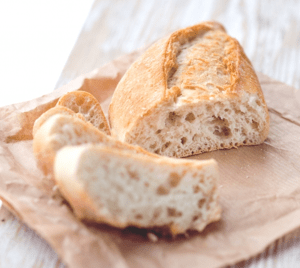Jimmy Fallon’s video below pokes fun at those who claim to follow a “gluten free” diet, yet these people can’t even tell you what gluten is. For this reason, I put together this post so you and I will not end up on Jimmy’s show looking foolish.
What is Gluten?
All wheat flours contain two proteins: Glutenin and Gliaden. When mixed with water, these two proteins mix and create an elastic network of proteins called Gluten. This elastic network of proteins traps air, much like a balloon. Different baking mixes have different concentrations of these two proteins depending on how much rise is needed in baking and the consistency required in the resulting baked good. So, for example, a cake mix is designed to fall apart easily, while a wheat bread requires more consistency. The higher the percentage of these proteins present in the baking mix, the stronger the bond and consistency of the baked good. To understand this a little better, check out this short video:
Celiac Disease
Celiac Disease is an autoimmune disorder that can occur in genetically predisposed people where the ingestion of gluten leads to damage in the small intestine. It is estimated to affect 1 in 100 people worldwide. Two and one-half million Americans are undiagnosed and are at risk for long-term health complications.” The definition provided by Celiac.org.
What Foods Include Gluten?
Gluten is found in wheat, rye, barley and any foods made with these grains. For a full list, see “What Foods Have Gluten?” on the Diabetes.org website. If you like your oats, don’t worry because pure oats are gluten free. However, if you buy commercially processed oats, chances are they were contaminated with gluten during some point of the processing.
Also noted in this article on the Diabetes.org website is a list of foods that might surprise you that they include gluten:
Gluten Surprises
You may not expect it, but the following foods can also contain gluten:
- broth in soups and bouillon cubes
- breadcrumbs and croutons
- some candies
- fried foods
- imitation fish
- some lunch meats and hot dogs
- malt
- matzo
- modified food starch
- seasoned chips and other seasoned snack foods
- salad dressings
- self-basting turkey
- soy sauce
- seasoned rice and pasta mixes
Symptoms of Celiac Disease and An Allergic Reaction to Gluten
The symptoms of Celiac Disease and an allergic reaction to Gluten are the same. The difference is that those with Celiac Disease who eat Gluten have inflammation of the inner walls of the small intestines making it harder for your body to absorb nutrients. Continued inflammation can lead to the deterioration of the interior wall of the small intestines. The symptoms for both include diarrhea, stomach upset, abdominal pain, and bloating. This article on WebMD strongly suggests that if you notice these symptoms go to your doctor and get tested for Celiac Disease, which is a blood test. “If you think you might have celiac disease, the biggest mistake is to begin a diet without being tested,” says Stefano Guandalini, MD, director of the University of Chicago Celiac Disease Center (also in the WebMD article).
Should You Go Gluten Free If You Do Not Have Allergies or Celiac Disease?
Giving up gluten, which has no nutritional benefits by itself, is fine. If you have no allergies and don’t have celiac disease, there is no health reason to give up gluten for gluten’s sake. In my diet, I don’t specifically avoid gluten, but I choose to avoid most of the foods that contain gluten even though I have no allergies nor celiac disease.
By avoiding foods with gluten, you most likely will lose unwanted body fat simply due to the fact that you are giving up mainly foods with high carbohydrate content. However, should you give up gluten, the foods you are generally giving up have many vitamins and fiber. Do your research and make sure you have a balanced diet, regardless. I go into detail about diet and good choices of macronutrients (proteins, carbohydrates, and fats) in my book, “Fat Burning Secrets“.
Here’s a related blog post you might like as well: Fruits and Vegetables: We are Carbohydrates, too!
As always, I urge you to take part in the conversation by adding a comment to this post and forwarding this post to your friends and family.
Good Health is the Greatest Wealth
Interested in getting in your best shape no matter what age? Learn how to lose belly fat naturally like Lawrence who in four weeks lost body fat but gained weight (muscle). Let’s stop using weight as the goal, because the more muscle you retain the more efficient your body is at burning fat.
————-
Sources:
A Closer Look at Gluten The Science of Good Cooking YouTube video
Wheat protein composition and properties of wheat glutenin in relation to breadmaking functionality. US National Library of Medicine-National Institutes of Health
Is gliadin really safe for non‐coeliac individuals? Production of interleukin 15 in biopsy culture from non‐coeliac individuals challenged with gliadin peptides US National Library of Medicine-National Institutes of Health
What is Celiac Disease Celiac.org
Going Gluten Free WebMD.com
The Truth About Gluten WebMD.com
Study Defines Difference Between Celiac Disease and Gluten Sensitivity CeliacCentral.org
What is Celiac Disease? verywell.com



